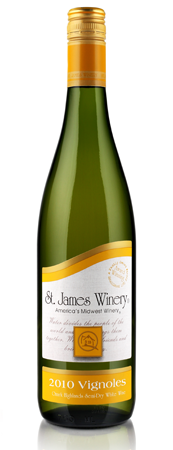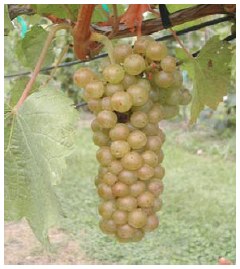Vignoles Rises Above Hybrid Stigma
From Ohio to Missouri, Vignoles is earning the praise of critics and wine drinkers who are now recognizing the quality of regional wines made from hybrid grapes. Vignoles is an especially versatile grape; it can be picked midseason or left on the vine until the grapes are raisins. Vignoles can also make dry wine, dessert wine, or ice wine.
See related story: River City Vignoles Wins 2012 Indy International Wine Competition
According to Andrew Meggitt, winemaker at St. James Winery in St. James, Missouri, the 2012 Vignoles harvest is three weeks earlier than past seasons. St. James normally harvests its 25 acres of Vignoles around August 15 and averages 60-70 tons of grapes total. As of August 1, 2012, they had been harvesting for a week.
Meggitt says flavor development is the key factor when determining the harvest date. His goal is to find the right balance of sugar and acid where the Vignoles fruit expresses itself perfectly. The primary flavors Meggitt says he is looking for in Vignoles are peach and mandarin orange.
The two executions of Vignoles produced at St. James are a semi-sweet and a dry wine. ‘We’ve gone to the St. James style, making different styles of the same grape, trying to appeal to two types of drinkers; dry and sweet,” Meggitt said.
Four hundred and fifty miles north of St. James on the shores of Traverse Bay, Jay Briggs, vineyard manager at Shady Lane Cellars in Suttons Bay, Michigan, says the harvest for their six acres of Vignoles usually occurs in October. He reports that his Vignoles holds acid for a long time when harvested at 21-24 brix and 13-17 grams of acid.
To continue reading this post, you must either subscribe or login.[login_form][show_to accesslevel=”annual-membership” ]
‘We let the grapes hang until the acids subside, but not too long or they get foxy, ” Briggs said. The 23-year-old Vignoles vines at Shady Lane are grown on a high wire trellis system. The vines are also currently in the first phase of trunk replacement.
Briggs adds that Shady Lane’s Vignoles, which is used to make their house white wine, is the last vine to reach bud break and the last to be pruned compared to the red hybrids in the vineyard. He believes that the late bud break protected the vines from frost damage during the late April freeze that occurred in Traverse City this year.[stextbox id=”custom” caption=”Vignoles: One of the Midwest’s Best Value Wines” shadow=”true” float=”true” align=”right” width=”250″]
St. James Late Harvest Vignoles: $9.99
Shady Lane Cellars 2009 Coop de Blanc: $10.00
Augusta Winery 2010 Vignoles: $14.60[/stextbox]
Tony Kooyumjian, owner and winemaker at Augusta Winery in Missouri, said that Augusta’s Vignoles is harvested according to flavor with the brix usually in the 23-26 range. He prefers to harvest Vignoles at night while it is colder and for the grapes to be brought to the winery within an hour of picking. The must is then chilled to 40 F before it is pressed. Once in the tanks, the fermentation process is stopped before completion to retain natural sugars. The dry style Vignoles contains 0.6% residual sugar, the semi-sweet 4%, and the ice wine is 17% sugar by volume.
Kooyumjian’s 2010 Vignoles Estate won a Best of Class award at the Missouri Wine Competition in 2012 for best dry white wine. He says that he also makes Vignoles in two other styles: semi-sweet and an ice wine.
Ann Miller, marketing manager at St. James Winery, said that their Vignoles is left on the vine as long as possible to concentrate the sugar. ‘We let the grapes hang until they are practically raisins,” she remarked. She says St. James Vignoles appeals to a broad spectrum of wine drinkers, regardless of their preference for sweet or dry. Vignoles’ aromatics are popular with all age groups Miller reports. She believes that the semi-sweet style pairs well with spicy food because the sugar in the wine balances the pepper in the food. She adds that their Vignoles sells well both in retail locations as well as the tasting room.
According to Erwin Elsner, a small fruit educator at the Michigan State University Grand Traverse County Extension, Vignoles is a cool climate cultivar that ripens relatively early and is suitable for a wide area that extends to USDA plant zone 4. He states that while the grape is adaptable to many soil conditions, it performs best at a pH of 6.5-7.0. Elsner adds that it is a high vigor cultivar, often spaced 8-9 feet in-row. The vines at the MSU Research Station are own-rooted vines that were planted in 1995 and are grown on a Hudson River Umbrella trellis system.
According to the profile written by Lisa Smiley of Iowa State University, Vignoles is a white interspecific hybrid, with V. vinifera, V. lincecumii, and V. rupestris in its background. Vignoles was bred in 1930 by J.F. Ravat and is sometimes called Ravat 51. It produces small, compact clusters, with small berries that can be prone to cracking and bunch rot.
Elsner says that this variety is fairly resistant to black rot, moderately susceptible to downy mildew, and very susceptible to powdery mildew and botrytis.
Fortunately, there are many effective fungal sprays available he says. Elsner adds that with good canopy management, powdery mildew is not much of a problem with Vignoles in northwest Michigan.
Briggs at Shady Lane sprays Vignoles with a fungicide called Pristine just before bunch close to control botrytis. Andrew Meggitt at St. James also says that botrytis can sometimes be an issue for his 25 acres of Vignoles. He says that St. James tries to avoid spraying, but will use a sulphur based organic product if necessary.
[/show_to][password-recovery-link text=’Lost Password? Click here for password recovery.’]





